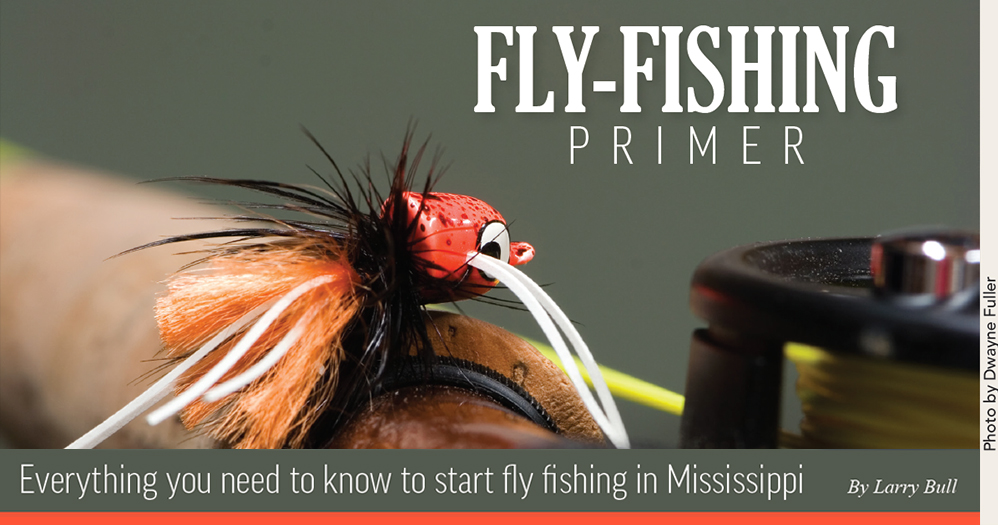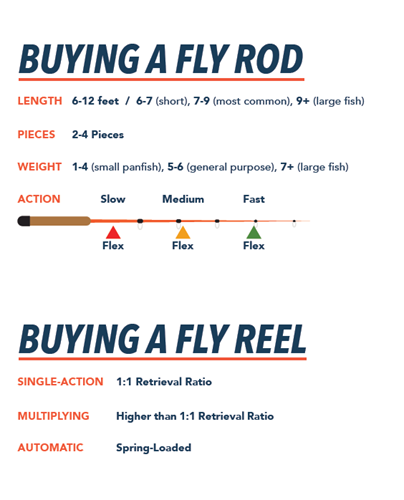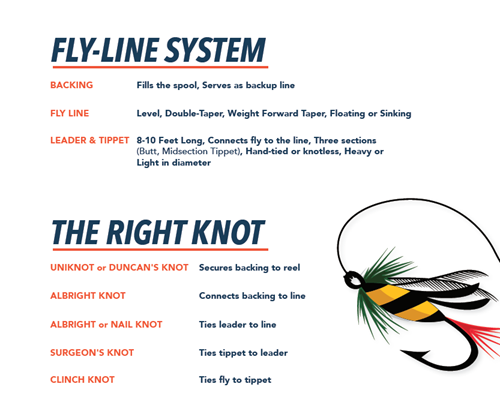Fishing Primer
5/20/2020 9:45:10 AM
By Larry Bull

It is mid-May and you are driving near your local fishing hole. Suddenly you pass through a swarming cloud of recently hatched mayflies. To the avid fly fisherman in Mississippi, this is a cue to get on the water with a popping bug tied to a fly rod and start catching bluegill.
To most people the term “fly fishing” suggests images of fishing for trout in a clear, fast-running mountain stream. However, fly tackle can also be used to catch a variety of fish species in Mississippi. But before you can fly fish, you must have the right gear.
Buying a fly rod
Several characteristics that you should consider before purchasing a fly rod are the rod’s length, the number of pieces that make up the rod, the rod’s weight, and the action of the rod. These factors come into play as you think about where you plan on fly fishing and the fish species that you are trying to catch. Fly rods are made from bamboo, fiberglass, or graphite. A graphite rod is generally best for beginners because it is lightweight, strong, and easier to cast.
 Fly rods range in length from 6 feet to more than 12 feet, though most are in the 7- to 9-foot range. Shorter rods (6-7 feet) are used for casting shorter distances and are best used in confined areas, such as a small, tree-lined stream. Longer rods (over 9 feet) help you cast longer distances and give you more line control. Longer rods also are heavier (therefore, tiring to use) and awkward to fish from a boat with two anglers. The 8½- to 9-foot rod is a good length for general purpose fish-ing and a good choice for the novice. To make the rods more portable, fly rods are broken down into multiple pieces. They come in two, three, or four pieces that are fitted together to make the final length.
Fly rods range in length from 6 feet to more than 12 feet, though most are in the 7- to 9-foot range. Shorter rods (6-7 feet) are used for casting shorter distances and are best used in confined areas, such as a small, tree-lined stream. Longer rods (over 9 feet) help you cast longer distances and give you more line control. Longer rods also are heavier (therefore, tiring to use) and awkward to fish from a boat with two anglers. The 8½- to 9-foot rod is a good length for general purpose fish-ing and a good choice for the novice. To make the rods more portable, fly rods are broken down into multiple pieces. They come in two, three, or four pieces that are fitted together to make the final length.
Unlike other rods designed to cast a weighted lure tied to the end of a fishing line, a fly rod is used to cast the heavier fly line that is attached to a light-weight fly or lure. To accomplish this, a specific weight fly rod must be matched with the same weight fly line to achieve the best casting performance. For example, a 7-weight rod should be rigged with a 7-weight fly line. Fly rods are classified or defined by the weight of line they can cast. Rods come in weights ranging from 1 to 16:
1-4 Designed to catch smaller fish such as panfish
5-6 Considered general-purpose rods
7-PLUS For bigger fish, such as large-mouth bass or striped bass
The heaviest weight rods are used to catch the largest saltwater game fish. Keep in mind that smaller weight rods are used to cast delicate flies, and heavier rods are used to cast larger, bulkier flies. Heavier rods with heavier lines also perform better in windy conditions.
The last thing to consider when shopping for a fly rod is the “action.” The action refers to how flexible the fly rod is, and where along the length of the rod that it bends. There are three types of action:
SLOW These are rods that bend in the lower third of the length (near the reel), extremely flexible, and best used in tight areas where short casts are required. This action is also used when fishing light tackle.
FAST These bend in the upper third of the rod and are stiff below the tip. This action facilitates longer casts and has the power to fight and land larger fish.
MEDIUM These rods fall between the other two action types. They are a compromise between the other two actions and are the most versatile rods available. This action is usually best for a beginner.
Buying a fly reel
Now that you have a rod picked out, it is time to purchase a reel to go with it. Three types of line retrieval systems are used in fly reels:
SINGLE-ACTION The simplest, most durable, and most popular reel to use. It has a 1:1 retrieval ratio (one turn of the reel’s handle equals one turn of the reel’s spool). Besides being simple to use, changing the line spool is easy.
MULTIPLYING It has a retrieval ratio higher than one. The spool turns multiple times with one turn of the handle, which allows for faster line retrieval. However, these reels are not as reliable as the single-action reel.
AUTOMATIC This reel is spring-loaded and the line is brought in with the touch of a lever attached to the reel. An automatic reel is probably the least desirable reel because it is heavy and prone to breaking.
Fly reels are made with either a spring and pawl drag system or a disc drag system. The drag is the resistance applied to the reel spool to prevent a fish from pulling line out too fast. The spring and pawl reel is usually paired with a lighter-weight rod that is used to catch panfish and other small fish. The disc drag system is more common and the better choice when fishing for larger fish such as largemouth bass. This system has the advantage of being adjustable with the turn of a knob.
A few other things to consider when purchasing a reel are the weight of the reel and the arbor size. It is important to match the weight of the reel with the corresponding weight of the rod and the fly line. The arbor size refers to the diameter of the inner spool that holds the fishing line. A larger arbor reduces line memory and facilitates a faster retrieval of the fishing line. One should also consider purchasing an extra spool when buying the reel. The second spool can make it easy to change line types if needed.

Fly-line system
A fly-line system consists of three parts:
BACKING The backing is made of a cord-like material that fills the spool of the reel and is tied to the fly line (dacron is a common material). The backing makes it easier to reel in the fly line, and it lets your fly line form a bigger coil on the reel, which reduces line memory. The backing also serves as backup line in the event that a big fish runs and takes all of the fly line off the reel. The backing line’s strength is rated with the familiar pound test designations common to other types of fishing lines.
FLY LINE Considered the most important part of the system, it is noticeably different from fishing line used in other types of fishing. The fly line is much heavier and provides the weight to load the rod and facilitate casting the light flies used in fly fishing. As mentioned, the fly rod will be rated for a certain line weight. It is important to pair the rod with the same weight line. In addition to weight, the fly line’s shape or taper needs to be considered. A “level” shape is the same diameter throughout the entire length of the line. This type of line will sufficiently load a rod for casting, but it is the worst line for distance casting and delicate presentations. The “double-taper” line will have the same taper at each end, which makes it reversible. These lines are designed for short to medium casts (20-50 feet) with normal size flies. Gentle presentations are also possible with this type of line. In the “weight forward” taper, the first 25-30 feet of line coming off the reel and through the rod guides is the heaviest. This line loads the rod more readily and makes casting easier. The weight-forward design allows you to make short to long casts (20-80 feet) with normal size flies.
The last aspect to consider for a fly line is whether to buy a floating or sinking line. As the name implies, floating lines float on top of the water. These lines are best when fishing for shallow feeding fish, and they are the ideal choice for dry flies. It can also be used with sinking flies, but the maximum depth that a lure can be fished is dependent on the length of the leader. Sinking lines allow anglers to get their flies into deeper water. Sink-ing rates are variable and range from 1-9 inches per second.
LEADER AND TIPPET Fly leaders are tapered monofilament or fluorocarbon strands that connect the fly fishing line to the fly. Leaders are usually at least 8-10 feet long, so the fly is far enough from the thick fly line. Leaders have three sections: butt, midsection, and tippet. Fly leaders are tapered from the thick, heavy butt to the narrow, thin fly tippet to help turn the fly over in casting. Fly fishing leaders are either hand-tied, with segments between knots; or they are knotless with a continuous taper from butt to fly tippet end. Small diameter lines are used for light flies and thicker, heavier lines are used with heavy flies. Tippets are usually tied onto the end of the leader to preserve the leader. If you don’t use a tippet each time you tie on a new fly, you will cut off part of the leader. Leaders and tippet are labeled to designate by the diameter and pounds it takes to break the line (e.g., 6X). Basically, the larger the number means the smaller the end diameter and the less pounds it takes to break it.

The right knot
Now that you have all of the line parts, it is time to connect them all together. All of the connections can be made with various knots. Starting at the reel, a Uniknot or a Duncan’s Knot can be used to secure the backing to the reel. To connect the backing to the fly line, an Albright Knot is recommended. This knot or a Nail Knot are good choices for tying the leader to the fly line. The best choice for tying the tippet to the leader is a Surgeon’s Knot. The Clinch Knot is a good choice for tying the fly to the tippet.
Several accessories are available that allow for knotless joining of the fly line to the leader. Metal-barbed eyelets can be used with hollow core floating fly lines. The barbed end is inserted into the fly line, and the leader is tied to the projecting eyelet. Another knotless connector on the market is the plastic leader connector.
Larry Bull is Assistant Director of Fisheries for MDWFP.









